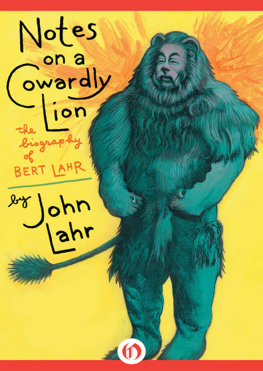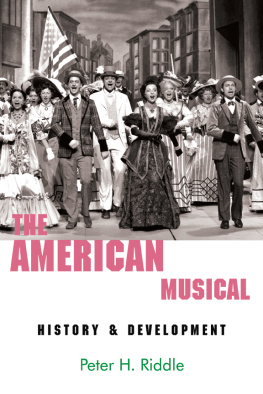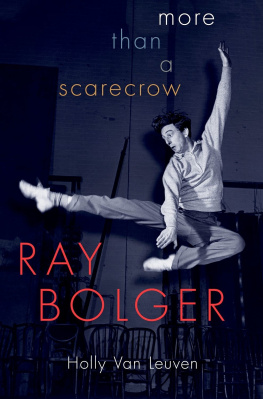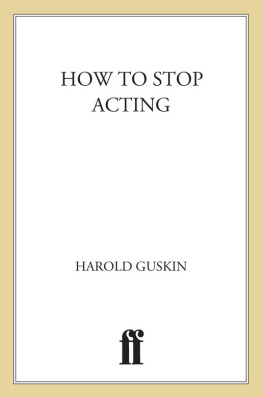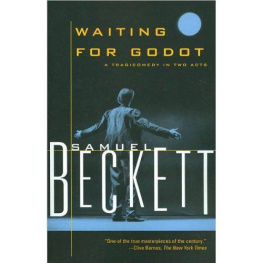Notes on a Cowardly Lion
The Biography of Bert Lahr
John Lahr

For Anthea, who gave a new life to this book and to me
Take the clowns those basically alien beings, fun makers their tumblings and falling over everything, their mindless running to and fro the hideously unsuccessful efforts to imitate their serious colleagues Are these ageless sons of absurdity, are they human at all? Are they, I repeat, human beings, men that could conceivably find a place in everyday life? In my opinion, it is pure sentimentality to say that they are human too, with the sensibilities of human beings and perhaps even with wives and children. I honour them and defend them against ordinary bad taste when I say no, they are not, they are exceptions, side splitting, world renouncing monks of unreason, cavorting hybrids, part human and part insane art.
Thomas Mann,
The Confessions of Felix Krull
Hamlet: Good my lord, will you see the players well bestowed? Do you hear, let them be well used, for they are the abstracts and brief chronicles of the time.
(II, ii, 500-3)
A Dramatic Chronology
| 1910 | Enters show business |
| 1916 | Tours with The Whirly Girly Musical |
| Comedy Success: |
| College Days |
| Garden Belles |
| 1917 | The Best Show in Town |
| 1919 | Folly Town (summer-run burlesque) |
| 1920 | Roseland Girls |
| 1921 | Keep Smiling |
| Tries out vaudeville act Whats the Idea? |
| 1922 | Vaudeville |
| 1925 | The Palace |
| 1927 | Harry Delmars Revels |
| 1928 | Hold Everything |
| 1929 | Faint Heart (Vita-Phone), first film |
| 1930 | Flying High |
| 1931 | Flying High (M-G-M) |
| 1932 | Hot-Cha! |
| George Whites Music Hall Varieties (1933) |
| Radio |
| 1934 | Life Begins at 8:40 |
| Happy Landing (a Monograph film) |
| 1935 | George Whites Scandals (1936) |
| 1936 | The Show Is On |
| 1938 | Hollywood: |
Love and Hisses (Twentieth Century-Fox) |
Merry-Go-Round of 1938 (Universal) |
Just Around the Corner (Twentieth Century-Fox) |
Josette (Twentieth Century-Fox) |
Zaza (Paramount), released in 1939 |
| 1939 | The Wizard of Oz (M-G-M) |
| Du Barry Was a Lady |
| 1942 | Sing Your Worries Away (RKO) |
| Ship Ahoy (M-G-M) |
| 1944 | Meet the People (M-G-M) |
| Seven Lively Arts |
| 1945 | Harvey (on tour) |
| 1946 | Burlesque |
| 1948 | Make Mine Manhattan (on tour) |
| 1949 | Always Leave Them Laughing (Warner Brothers) |
| 1951 | Two on the Aisle |
| Mr. Universe (Eagle-Lion Productions) |
| 1954 | Rose Marie (M-G-M) |
| 1956 | The Second Greatest Sex (Universal) |
| Waiting for Godot |
| Androcles and the Lion (television) |
| The School for Wives (television) |
| 1957 | Hotel Paradiso |
| Visit to a Small Planet (summer stock) |
| 1959 | The Girls Against the Boys |
| Romanoff and Juliet (on tour) |
| 1960 | A Midsummer Nights Dream, American |
| Shakespeare Festival |
| Receives Best Shakespearean Actor of the |
| Year Award |
| 1962 | The Beauty Part |
| Ten Girls Ago (unreleased film) |
| 1964 | Foxy, Wins Tony Award for Best Musical |
| Actor |
| The Fantasticks (Hallmark Hall of Fame) |
| The Birds (Ypsilanti Greek Theater) |
| The Night They Raided Minskys (United Artists) |
RECORDS
Two on the Aisle (Decca)
Waiting for Godot (Columbia)
The Wizard of Oz (M-G-M)
Great Moments from the Hallmark Hall of Fame
Preface: The Lion and Me
On November 6th, 1998, twenty-six years after The Wizard of Oz was last released and on the eve of its sixtieth anniversary, a spiffy, digitally remastered print of the film arrived in eighteen hundred movie theatres throughout the land. With a rub rub here and a rub rub there, The Wizard of Oz, which never looked bad, has been made to look even better. Dorothys ruby slippers are rubier. Emerald City is greener. Kansas, a rumpled and grainy black-and-white world, has been restored to a buff, sepia Midwestern blandness. And, since everything that rises nowadays in America ends up in a licensing agreement, new Oz merchandise will shower the planet like manna from hog heaven.
The last time I watched The Wizard of Oz from start to finish was in 1962, at home, with my family. My father, Bert Lahr, who played the Cowardly Lion, was sixty-seven. I was twenty-one; my sister, Jane, was nineteen. My mother Mildred, who never disclosed her age, was permanently thirty-nine. By then, as a way of getting to know the friendly absence who answered to the name of Dad, I was writing a biographyit was published, in 1969, as Notes on a Cowardly Lionand I used any occasion with him as field work. This was the first time wed sat down together as a family to watch the film, but not the first time a Lahr had been secretly under surveillance while viewing it. The family album had infra-red photographs of Jane and me in the mid-fortiesJane in a pinafore, me in short pantsslumped in a darkened movie house as part of a row of well-dressed, bug-eyed kids. Jane, who was five, is scrunched in the back of her seat in a state of high anxiety about the witchs monkey henchmen. Im trying to be a laid-back big brother: my face shows nothing, but my hands are firmly clutching the armrests.
Recently, Jane told me that for weeks afterward shed had nightmares about lions, but what had amazed her most then was the movies shift from black-and-white to Technicolor, not the fact that Dad was up onscreen in a lions suit. Once, around that time, while waiting up till dawn for my parents to return from a costume party, I heard laughter and then a thud in the hall; I tiptoed out to discover Dad dressed in a skirt and bonnet as Whistlers Mother, passed out on the floor. That was shocking. Dad dressed as a lion in a show was what he did for a living, and was no big deal. Our small, sunless Fifth Avenue apartment was full of Dads disguises, which hed first used onstage and in which he now occasionally appeared on TV. The closet contained a woodsmans props (axe, jodhpurs, and boots); a policemans suit and baton; a New York Giants baseball outfit, with cap and cleats. The drawers of an apothecarys cabinet, which served as a wall-length bedroom bureau, held his toupes, starting pistol, monocle, putty noses, and makeup. In the living room, Dad was Louis XV, complete with scepter and periwig, in a huge oil painting made from a poster for Cole Porters Du Barry Was a Lady (1939); in the bedroom, he was a grimacing tramp in Richard Avedons heartbreaking photograph of him praying, as Estragon, in Waiting for Godot (1956).

